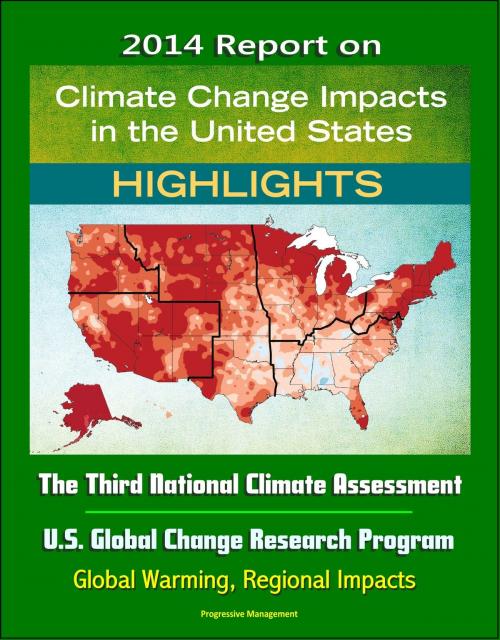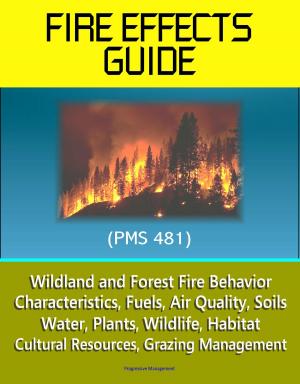2014 Report on Climate Change Impacts in the United States: The Third National Climate Assessment, U.S. Global Change Research Program (Highlights) - Global Warming, Regional Impacts
Nonfiction, Social & Cultural Studies, Political Science, Government, Public Policy, Science & Nature, Science, Earth Sciences| Author: | Progressive Management | ISBN: | 9781310212826 |
| Publisher: | Progressive Management | Publication: | May 8, 2014 |
| Imprint: | Smashwords Edition | Language: | English |
| Author: | Progressive Management |
| ISBN: | 9781310212826 |
| Publisher: | Progressive Management |
| Publication: | May 8, 2014 |
| Imprint: | Smashwords Edition |
| Language: | English |
This highly publicized report, issued in May 2014, represents the highlights of the Third National Climate Assessment: Climate Change Impacts in the United States. As required by the Global Change Research Act of 1990, this report has collected, evaluated, and integrated observations and research on climate change in the United States. It focuses both on changes that are happening now and further changes that we can expect to see throughout this century. This report is the result of a three-year analytical effort by a team of over 300 experts, overseen by a broadly constituted Federal Advisory Committee of 60 members. It was developed from information and analyses gathered in over 70 workshops and listening sessions held across the country. It was subjected to extensive review by the public and by scientific experts in and out of government, including a special panel of the National Research Council of the National Academy of Sciences. This process of unprecedented rigor and transparency was undertaken so that the findings of the National Climate Assessment would rest on the firmest possible base of expert judgment.
Climate Change and the American People - OVERVIEW * REPORT FINDINGS * List of Report Findings * Climate Trends * Finding 1 Our Changing Climate * Finding 2 Extreme Weather * Finding 3 Future Climate * Finding 4 Widespread Impacts * Finding 5 Human Health * Finding 6 Infrastructure - Urban * Transportation * Energy * Finding 7 Water - Water Resources * Energy, Water, and Land Use * Finding 8 Agriculture * Finding 9 Indigenous Peoples * Finding 10 Ecosystems - Ecosystems and Biodiversity * Forests * Land Use and Land Cover Change * Biogeochemical Cycles * Finding 11 Oceans * Finding 12 Responses - Adaptation • Mitigation • Decision Support * REGIONS * Introduction * Northeast * Southeast & Caribbean * Midwest * Great Plains * Southwest * Northwest * Alaska * Hawaii & Pacific Islands * Rural Communities * Coasts * Future National Assessments * Concluding Thoughts
The introduction states: Climate change, once considered an issue for a distant future, has moved firmly into the present. Corn producers in Iowa, oyster growers in Washington State, and maple syrup producers in Vermont are all observing climate-related changes that are outside of recent experience. So, too, are coastal planners in Florida, water managers in the arid Southwest, city dwellers from Phoenix to New York, and Native Peoples on tribal lands from Louisiana to Alaska. This National Climate Assessment concludes that the evidence of human-induced climate change continues to strengthen and that impacts are increasing across the country.
Americans are noticing changes all around them. Summers are longer and hotter, and extended periods of unusual heat last longer than any living American has ever experienced. Winters are generally shorter and warmer. Rain comes in heavier downpours. People are seeing changes in the length and severity of seasonal allergies, the plant varieties that thrive in their gardens, and the kinds of birds they see in any particular month in their neighborhoods.
Other changes are even more dramatic. Residents of some coastal cities see their streets flood more regularly during storms and high tides. Inland cities near large rivers also experience more flooding, especially in the Midwest and Northeast. Insurance rates are rising in some vulnerable locations, and insurance is no longer available in others. Hotter and drier weather and earlier snow melt mean that wildfires in the West start earlier in the spring, last later into the fall, and burn more acreage. In Arctic Alaska, the summer sea ice that once protected the coasts has receded, and autumn storms now cause more erosion, threatening many communities with relocation.
This highly publicized report, issued in May 2014, represents the highlights of the Third National Climate Assessment: Climate Change Impacts in the United States. As required by the Global Change Research Act of 1990, this report has collected, evaluated, and integrated observations and research on climate change in the United States. It focuses both on changes that are happening now and further changes that we can expect to see throughout this century. This report is the result of a three-year analytical effort by a team of over 300 experts, overseen by a broadly constituted Federal Advisory Committee of 60 members. It was developed from information and analyses gathered in over 70 workshops and listening sessions held across the country. It was subjected to extensive review by the public and by scientific experts in and out of government, including a special panel of the National Research Council of the National Academy of Sciences. This process of unprecedented rigor and transparency was undertaken so that the findings of the National Climate Assessment would rest on the firmest possible base of expert judgment.
Climate Change and the American People - OVERVIEW * REPORT FINDINGS * List of Report Findings * Climate Trends * Finding 1 Our Changing Climate * Finding 2 Extreme Weather * Finding 3 Future Climate * Finding 4 Widespread Impacts * Finding 5 Human Health * Finding 6 Infrastructure - Urban * Transportation * Energy * Finding 7 Water - Water Resources * Energy, Water, and Land Use * Finding 8 Agriculture * Finding 9 Indigenous Peoples * Finding 10 Ecosystems - Ecosystems and Biodiversity * Forests * Land Use and Land Cover Change * Biogeochemical Cycles * Finding 11 Oceans * Finding 12 Responses - Adaptation • Mitigation • Decision Support * REGIONS * Introduction * Northeast * Southeast & Caribbean * Midwest * Great Plains * Southwest * Northwest * Alaska * Hawaii & Pacific Islands * Rural Communities * Coasts * Future National Assessments * Concluding Thoughts
The introduction states: Climate change, once considered an issue for a distant future, has moved firmly into the present. Corn producers in Iowa, oyster growers in Washington State, and maple syrup producers in Vermont are all observing climate-related changes that are outside of recent experience. So, too, are coastal planners in Florida, water managers in the arid Southwest, city dwellers from Phoenix to New York, and Native Peoples on tribal lands from Louisiana to Alaska. This National Climate Assessment concludes that the evidence of human-induced climate change continues to strengthen and that impacts are increasing across the country.
Americans are noticing changes all around them. Summers are longer and hotter, and extended periods of unusual heat last longer than any living American has ever experienced. Winters are generally shorter and warmer. Rain comes in heavier downpours. People are seeing changes in the length and severity of seasonal allergies, the plant varieties that thrive in their gardens, and the kinds of birds they see in any particular month in their neighborhoods.
Other changes are even more dramatic. Residents of some coastal cities see their streets flood more regularly during storms and high tides. Inland cities near large rivers also experience more flooding, especially in the Midwest and Northeast. Insurance rates are rising in some vulnerable locations, and insurance is no longer available in others. Hotter and drier weather and earlier snow melt mean that wildfires in the West start earlier in the spring, last later into the fall, and burn more acreage. In Arctic Alaska, the summer sea ice that once protected the coasts has receded, and autumn storms now cause more erosion, threatening many communities with relocation.















